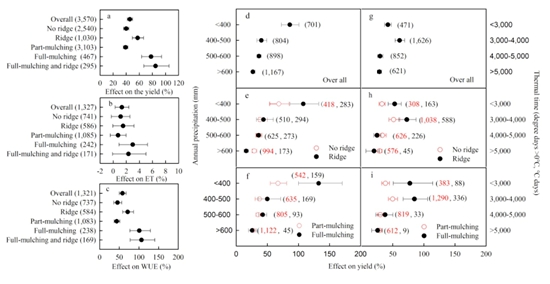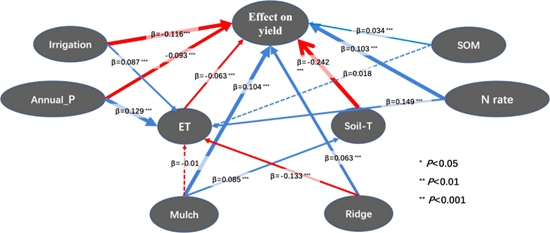The Use of Plastic Film Mulching in China Increased Crop Yield and Water Use Efficiency
Recently, research teams of the Institute of Environment and Sustainable Development in Agriculture (IEDA), in cooperation with the China Agricultural University and other units, had confirmed that the plastic film mulching technology (PM) as a simple, low-cost technique can significantly improve crop yield and water use efficiency,which provides a successful example for other countries in the context of growing global food demand. The findings are published online in Journal National Science Reviews.
This research was based on a Meta-analysis of 3570 groups of field experiment data from 788 research sites in China. Results showed that film mulching technology improved crop yields and water use efficiency by 45.5% and 58.0% respectively across China, and this technology was more effective in areas where annual precipitation is less than 400 mm and accumulated temperature(greater than 0ºC ) ranges from 3,000 to 4,000 ºCd. Based on the average yield increase by PM and the total area under plastic film-mulching in 2012, the estimated contribution to the yield increase for the three main grain crops ( wheat, maize and rice ) by plastic film mulching was 30 million tons in China. This was equivalent to the grain production from an extra 3.9 million hectares of arable land.
Similar to other technology, PM has shown ‘side effects’. Past applications of PM have led to the accumulation of plastic film residue in soil (referred to as ‘white pollution’), which, in some cases, has resulted in a loss of soil fertility, reduction of water permeability, accelerated decomposition of organic carbon, and other problems. In the future, the full life cycle analysis of PM techniques should be strengthened to explore the potential impact of mulch decomposition on soil health and downstream ecosystems, new and degradable films are being developed to minimize the negative impacts on soil and the broader environment.
The research was supported by the National Basic Research Program of China, the National Natural Science Foundation of China, the Chinese National Programs of Science and Technology Development, etc.
Original Link:https://doi.org/10.1093/nsr/nwaa146

Figure 1∣Percent increase in crop yield (a), evapotranspiration (ET) (b) and water-use efficiency (WUE) (c) in response to different types of plastic film mulching (PM) compared to no mulching, and percent increase in crop yield along precipitation and thermal time gradients (d-i).

Figure 2| Partial least squares path models of the factors impacting the effects of mulching on yield. The path coefficients (β values) were computed from regressions and the estimated strength, and the directions (red arrow = negative; blue arrow = positive) of relationships between variables were estimated.
By Sun Dongbao (sundongbao@caas.cn)
-
 Apr 18, 2024Opening Ceremony of the Training Workshop on Wheat Head Scab Resistance Breeding and Pest Control in Africa Held in CAAS
Apr 18, 2024Opening Ceremony of the Training Workshop on Wheat Head Scab Resistance Breeding and Pest Control in Africa Held in CAAS -
 Apr 03, 2024IPPCAAS Co-organized the Training Workshop on Management and Application of Biopesticides in Nepal
Apr 03, 2024IPPCAAS Co-organized the Training Workshop on Management and Application of Biopesticides in Nepal -
 Mar 28, 2024Delegation from the School of Agriculture and Food Science of University College Dublin, Ireland Visit to IAS, CAAS
Mar 28, 2024Delegation from the School of Agriculture and Food Science of University College Dublin, Ireland Visit to IAS, CAAS -
 Mar 25, 2024Director of World Food Prize Foundation visited GSCAAS
Mar 25, 2024Director of World Food Prize Foundation visited GSCAAS -
 Mar 20, 2024Institute of Crop Sciences (ICS) and Syngenta Group Global Seeds Advance Collaborative Research in the Seed Industry
Mar 20, 2024Institute of Crop Sciences (ICS) and Syngenta Group Global Seeds Advance Collaborative Research in the Seed Industry
